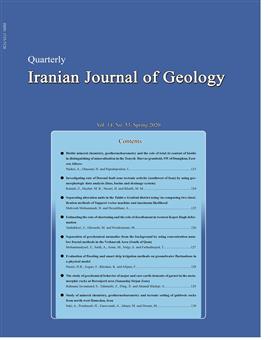Biotite mineral chemistry, geothermobarometry and the role of total Al content of biotite in distinguishing of mineralization in the Touyeh- Darvar granitoid, SW of Damghan, Eastern Alborz.
Subject Areas :Azin Naderi 1 , Habibolah Ghasemi 2 , Lamberini Papadopoulou 3
1 -
2 -
3 -
Keywords: Biotite chemistry Geothermobarometry Touyeh- Darvar granitoid Damghan Eastern Alborz.,
Abstract :
Touyeh- Darvar granitoid pluton is situated in the south of eastern Alborz zone (45Km SW of Damghan in Semnan province). This pluton has intruded into the late Paleozoic formations (including Barut and Lalun). Based on the field observations and petrographic studies, the pluton is composed of monzonites, quartz monzonite and monzodiorite. In terms of mineralogy, the Touyeh- Darvar granitoid consists of plagioclase, orthoclase, quartz, ± hornblende and ±biotite. Accessory minerals consists of ilmenite, magnetite, zircon, apatite, titanite and pyrite. Sericite, epidote, calcite, and chlorite are considered as secondary phases. The iron-rich biotite is the most significant mafic mineral which are situated in the alkaline and anorogenic biotite fields. The total Al content of biotite in granitic rocks can be a useful indicator for distinguishing between mineralized and non-mineralized granitic rocks. The presence of mineral veins from oxides and hydroxides of iron and manganese, fluorite, barite, lead and zinc in the host rock of this pluton also confirms that the biotite composition is useful for mineralization potential study of this pluton. Applying the thermometry based on the Ti content of biotite and barometery based on total Al content of biotite resulted in calculating temperature ranges of 650–730°C and pressures lower than 1Kb for stopping the exchange and final equilibrium of this mineral in the pluton.


